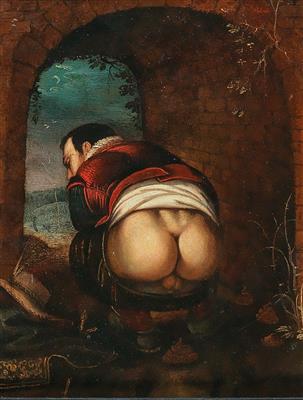School of Prague, circa 1600

A man relieving himself,
oil on copper, 27 x 21 cm, framed
The present picture by its subject, costume and sombre palette may be located stylistically with artworks created around the Rudolphine court in Prague at the turn of the 17th Century. The origin of the iconography however, goes back further, to the latin verses composed by the Italian humanist Andrea Alciato to accompany the Renaissance’s first emblem book, published in Augsburg in 1531. That work, and many of the subsequent editions of the Emblemata contained various woodcuts of defecation to accompany Alciato’s emblem of ‘Adversus naturam peccantes‘ (sins against a nature).
That a scene of such vulgarity could be the subject of artistic erudition is evidenced in the work also of Pieter Brueghel the Elder. The widely disseminated Seven Deadly Sins published by Hieronymus Cock after Brueghel’s designs contained such a motif in the Luxuria and Superbia sheets. Most prescient for the present picture is Brueghel’s 1563 Tower of Babel which was in Rudolf II’s collection and is now conserved in the Kunsthistorisches Museum in Vienna (inv. no. 1026). In the foreground King Nimrud’s vain procession can be seen, while the gigantic folly of his tower of Babel is erected behind him, a crime against god. Beneath the tower a man can be seen defecating. Without knowing who commissioned the present work, it is hard to ascribe a more precise meaning to it, but, like the emblems of Alciato and the oeuvre of Brueghel, it is no doubt rapt with mockery and satire.
Specialist: Damian Brenninkmeyer
 Damian Brenninkmeyer
Damian Brenninkmeyer
+43 1 515 60 403
damian.brenninkmeyer@dorotheum.at
09.06.2020 - 16:00
- Realized price: **
-
EUR 22,800.-
- Estimate:
-
EUR 10,000.- to EUR 15,000.-
School of Prague, circa 1600
A man relieving himself,
oil on copper, 27 x 21 cm, framed
The present picture by its subject, costume and sombre palette may be located stylistically with artworks created around the Rudolphine court in Prague at the turn of the 17th Century. The origin of the iconography however, goes back further, to the latin verses composed by the Italian humanist Andrea Alciato to accompany the Renaissance’s first emblem book, published in Augsburg in 1531. That work, and many of the subsequent editions of the Emblemata contained various woodcuts of defecation to accompany Alciato’s emblem of ‘Adversus naturam peccantes‘ (sins against a nature).
That a scene of such vulgarity could be the subject of artistic erudition is evidenced in the work also of Pieter Brueghel the Elder. The widely disseminated Seven Deadly Sins published by Hieronymus Cock after Brueghel’s designs contained such a motif in the Luxuria and Superbia sheets. Most prescient for the present picture is Brueghel’s 1563 Tower of Babel which was in Rudolf II’s collection and is now conserved in the Kunsthistorisches Museum in Vienna (inv. no. 1026). In the foreground King Nimrud’s vain procession can be seen, while the gigantic folly of his tower of Babel is erected behind him, a crime against god. Beneath the tower a man can be seen defecating. Without knowing who commissioned the present work, it is hard to ascribe a more precise meaning to it, but, like the emblems of Alciato and the oeuvre of Brueghel, it is no doubt rapt with mockery and satire.
Specialist: Damian Brenninkmeyer
 Damian Brenninkmeyer
Damian Brenninkmeyer
+43 1 515 60 403
damian.brenninkmeyer@dorotheum.at
|
Buyers hotline
Mon.-Fri.: 10.00am - 5.00pm
old.masters@dorotheum.at +43 1 515 60 403 |
| Auction: | Old Master Paintings |
| Auction type: | Saleroom auction |
| Date: | 09.06.2020 - 16:00 |
| Location: | Vienna | Palais Dorotheum |
| Exhibition: | 02.06. - 09.06.2020 |
** Purchase price incl. charges and taxes
It is not possible to turn in online buying orders anymore. The auction is in preparation or has been executed already.
